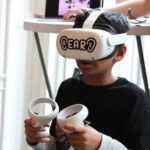Explore the transformative world of AR vs VR with our comprehensive guide. Discover the history, differences, applications across industries, current trends, and future outlook of AR and VR technologies, and learn how they are revolutionizing gaming, healthcare, education, and more. Dive into the immersive experiences shaping our digital future.
Introduction to AR and VR
In recent years, Augmented realities (AR) and Virtual reality (VR) have objected as a pair of transformative technologies, providing immersed experiences that shove the boundaries of human perceptions. From enhanced gaming experiences to revolutionizing healthcare, education, and more, AR and VR are reshaping the way we interact with digital content and the world around us! In this full, we’ll deeply look at AR and VR, exploring their histories, diversities, applications across businesses, current trends, and future outlook gages.
Historical Development of AR and VR
In recent years, Augmented realities (AR) and Virtual reality (VR) have objected as a pair of transformative technologies, providing immersed experiences that shove the boundaries of human perceptions. From enhanced gaming experiences to revolutionizing healthcare, education, and more, AR and VR are reshaping the way we interact with digital content and the world around us! In this full, we’ll deeply look at AR and VR, exploring their histories, diversities, applications across businesses, current trends, and future outlook gages.

The genesis of Augmented Realities (AR) and Virtual Realities (VR) can be traced back to pioneering efforts in the mid-20th centuries, although their widespread adoptions and technological maturation occurred in more recent decades. In the 1960s, Morton Heilig conceptualized the Sensorama, a machinery designed to stimulate multiple senses simultaneously, foreshadowing the immersing experiences central to VR. Subsequently, in 1968, Ivan Sutherland developed the first head-mounted displays systems, termed the “Swords of Damocles,” laying the groundwork for modern VR devices.
Advancements in computerized graphics and processed powers during the 1980s and 1990s propelled AR and VR into the realms of feasibilities for commercial applications. Notably, in 1992, Louis Rosenberg created the Virtual Fixtures systems, pioneering the uses of AR for military training’s purposes. Concurrently, the entertainment industries explored VR’s potentials, with Sega’s VR-1 motion simulator and Nintendo’s Virtual Boys introducing immersing gaming experiences to consumers.
The turns of the 21st century witnessed accelerated progresses in AR and VR technologies, fuelled by the convergence of computing’s powers, miniaturizations, and enhanced display’s capabilities. Innovations such as Google’s Glasses projects and the Oculus Rift headsets marked significant milestones, democratizing access to AR and VR experiences. Moreover, the integrations of AR functionalities into smartphones and tablets broadened their applicability beyond specialized hardwired, catalyzing the widespread adoptions across various sectors. These historical developments serve as pivotal points in the evolutions of AR and VR, illuminating the trajectory from theoretical concepts to transformative technologies with profound implications for myriad industries.
Technological Foundations of AR and VR
By its heart, Augmented reality (AR) and virtual reality(VR) experiences lay over complex technological infrastructures designed blending digital contents among user’s perception of reality or creating immersive virtual environments.
AR relies on a combination of hardware components and software algorithms for overlaying digital information into the user’s view of the actual world. Key hardware elements included sensors for detecting the user’s surroundings, cameras for capturing real-world imaging, and displays, like smart glasses or smartphone screens, for rendered augmented content. Software platforms such as AR Kit (for iOS) and ARCore (for Android) provide developers with tools for creating AR applications, enabling functionalities like marker-based tracking, object recognition, and special mapping.
In contrast, VR necessitates specialized hardware for immersed users in complete virtual environments. VR headsets, equipped by high-resolution displays and motion-tracking sensors, replace the user’s field of view by computer-produced imaging. Tracking systems, likely inside-out or outside-in tracking, monitor user’s movements, enabling real-time interaction within the virtual space. Additionally, VR experiences often incorporate input devices like hand controllers or haptic feedback systems for enhancing users’ engagement and to facilitate interaction among virtual objects.
Over many years, advancements in hardware minimization, display technologies, and computational capabilities have propelled AR and VR devices from bulky, prototype stages to slick, consumer-friend products, laying the foundations for their adoption and integration into many aspects of everyday life.
Key Differences Between AR and VR
Augmented Reality (AR) and Virtual Reality (VR) epitomize two distinct paradigms of immersive technology, each offering unorthodox experiences and applications. Differentiated by their interaction with reality, level of immersion, and intended use cases, AR and VR cater to diverse user ebbs and flows and scenarios.
At its core, AR augmentations the user’s perception of the real world by overlaying digital information onto their viewings. This augmentation enhances the user’s environment by providing contextually relevant data or interactive elements, all whilst preserving their awareness of the physical surroundings. Examples of AR applications range from simple smartphone apps displaying information about nearby landmarks to more sophisticated implementations like Microsoft’s HoloLens, which projects holographic objects into the user’s field of viewpoint.
On the other hand, VR immerses users in entirely virtual environments, totally replacing their perception of reality with computer-generated simulations. By donning a VR headset, users are transported to immersive digital realms where they can explore, interact, and engage with virtual objects and environments. VR experiences span a wide spectrum, from gaming and entertainment to simulation training, therapy, and architectural visualizations.
One of the fundamental differences between AR and VR lie in their interaction with reality. AR enhances the user’s real-world environment by overlaying digital content onto it, thereby augmenting their perception and interaction with the physical world. In contrast, VR creates a complete separation from reality, immersing users in simulated environments where physical surroundings are entirely replaced by virtual constructs.
The level of immersion offered by AR and VR also vary significantly. AR maintains a partial immersion, allowing users to perceive and interact with both digital and physical elements simultaneously. This partial immersion preserves the user’s connection to the real world, enabling contextually rich experiences without completely isolating them from their surroundings. In contrast, VR delivers full immersion, transporting users to entirely virtual environments where they are fully enveloped in digital experiences. This complete immersion enables deep engagement and presence within the virtual world, offering unparalleled levels of escapism and interactivity.
The applications of AR and VR are diverse, reflecting their respective strengths and capabilities. AR finds utility in scenarios where contextual information and real-world interactions are paramount, such as navigations, education, remote assistance, and retail experiences. For instance, AR-powered navigation apps overlay route guidance onto the user’s view, enhancing their spatial awareness and simplifying navigation in unfamiliar environments. Similarly, AR educational applications leverage interactive overlays to provide immersive learning experiences, enabling students to visualize complex concepts in a touchable manner.
Conversely, VR excels in creating immersive simulations and experiences that transcend physical limitations. VR gaming offers unparalleled levels of immersion and interactivities, allowing players to step into virtual worlds and engage in dynamic gameplay experiences. Simulation training in VR enables hands-on learning in safe, controlled environments, benefitting industries such as healthcare, aviation, and manufacturing. Moreover, VR therapy applications leverage immersive environments to treat phobias, PTSD, and anxiety disorders, providing patients with exposure-based therapies in virtual settings.
Emerging technologies are blurring the lines between AR and VR, giving rise to hybrid experiences that combine elements of both modalities. Mixed Reality (MR) merges virtual and physical worlds, enabling interactions with digital content anchored in the real environment. MR devices like the Magic Leap One and the Microsoft HoloLens offer spatial computing capabilities, allowing users to interact with holographic objects integrated seamlessly into their surroundings. These hybrid experiences leverage the strengths of both AR and VR, offering users dynamic and immersive interactions that bridge the gap between digital and physical realities.
In summary, while AR and VR represent distinct approaches to immersive technology, they share a common goal of transforming human-computer interaction and reshaping our perceptions of reality. As technologies continue to evolve and merge, the boundaries between AR and VR will continue to blur, giving rise to new possibilities and applications that harness the power of immersive experiences.
Applications of AR in Various Industries

Augmented Reality (AR) is experiencing broad adoption in various industries, revolutionizing the way companies engage with customers and employees alike. In gaming, AR experiences like Pokémon STOP have captivated millions, merging digital creatures with real-world surroundings to generate interactive gaming experiences. In retail, AR applications enable customers to visualize products in their own spaces before deciding to purchase, enriching the online shopping experience and decreasing returns.
In healthcare, AR technology is transforming patient care and medical training. Surgeons AR overlays during procedures to visualize critical anatomical designs, enhancing precision and patient outcomes. Medical students benefit from AR simulations that imitate surgical situations, offering hands-on training in a safe environment without risks.
Education is an additional sector ripe for AR innovation, with applications ranging from interactive textbooks to virtual field excursions. AR boosts learning by contextualizing information and offering immersive experiences that cater to various learning styles. Students can explore historical locations, dissect virtual organisms, or interact with 3D moulds, making learning more intriguing and impactful.
In manufacturing, AR-enabled maintenance and assembly instructions enhance workflow efficiency and reduce mistakes. By overlaying digital instructions onto physical equipment, workers can execute tasks with increased accuracy and speed, decreasing downtime and amplifying productivity. Generally, the versatility and flexibility of AR technology persist in driving innovation across industries, paving the way for a more connected and immersive future.
Applications of VR in Various Industries

Virtual Reality (VR) has revolutionized numerous industries by offering immersive and interactive experiences that transcend physical limitations! In gaming, VR has created a new dimension of engagement, allowing players to step into virtual worlds and experience dynamic gameplay with unparalleled imbursement! Titles like “Beat Saber” and “Half-Life: Alyx” have set new standards for interactive entertainment.
In simulation training, VR is invaluable, providing realistic scenarios for hands-on learning without the associated risks. For example, pilots using VR flight simulators to practice maneuvers and emergency procedures, enhancing their skills in a control environment. Similarly, VR is used in military training to simulate combat scenarios, improves preparedness and decision-making.
Healthcare is another sector’s significant impact by VR technology. Medical professionals use VR for surgical training, allowing them to practice complex procedures in a virtual setting. Additionally, VR therapy applications help treat conditions such as PTSD, phobias, and anxiety disorders by exposing patients to control virtual environments, aiding in desensitizing and coping strategies.
Virtual meetings and remote collaboration have also transformed by VR, especially in the era of remote work. Platforms like Spatial and Altspace VR enable people to meet in virtual spaces, fostering collaboration and interaction as if they were in the same room. This technology enhances communication, creation, and productivity.
In architecture and real estate, VR allows stakeholders to walk through virtual models of buildings before constructions begin, offering a realistic sense of space and design. This capability helps in making informed decisions and reducing costly alterations during the building processes.
Overall, the immense potential of VR continues to drive innovation across various fields, transforming how we interact, learn, and entertain ourselves, and paving the way for new possibilities in a digitally enhanced world! This ensures that the structures and formatting are consistent with the previous sections, providing a clear and comprehensive overview of VR applications.
Current Trends and Innovations in AR and VR
Recent advancement in Augmented Reality (AR) and Virtual RealityVR technology has propelled these immersive experiences to newerest heights, with multiple trends and innovations shaping their evolution.
Spatial computing, which combines AR and VR with real-world spatial awareness, are a significant trend reshaping how users interact with digit content. By anchoring virtual objects and experience to physical location, spatial computing enables seamless integration of the digital and physical world, opening new possibilities for immersive application.
Volumetric capture is another emerging trend that enhances the realism of AR and VR experience by capturing real-world objects and environments in three dimensions. This technology enables more reality-based interaction with virtual content, creating an immersive environment that closely mimics the physical world.
Haptic feedback systems are also gaining prominence, adding tactile sensation to AR and VR experience. By simulating the sense of touch, haptic feedback enhances immersion and interaction, allowing users to feel and manipulate virtual objects as if they were real.
Social VR is another area of innovation, facilitators immersive social interaction in virtual environment. With social VR platform, user can connected with friend, colleague, and stranger from around world in shared virtual space, foster collaboration, communication, and community-building.
AI, machine learning, and computer vision are playing increased critically role in advancing AR and VR experience. These technology enable real-time object recognition, scene understanding, and content personalization, enhancing the quality and realism of immersive experience.
Overall, these trend and innovative are driving the continued growth and maturations of AR and VR technology, paving the ways for more compelling and immersive experience in futures.
Challenges and Limitations of AR and VR
Despite the absolutely unique advancement in Augmented Reality (AR) and Virtual Reality(VR) technology, various challenges and constraints persist, hindering widespread adoption and optimal user experiences.
One significant challenge is hardware restraints, particularly in VR, where high-quality immersive experiences demand powerful compute resources and advanced display technologies. The cost and heaviness of VR headsets remain barriers to entry for many consumers, limiting accessibility and adoption.
Content creation introduces another hurdle, especially in AR, where developing engaging and contextually relevant experiences requires specialized skills and resources. The lack of standardized tools and workflows complicates the creation and distribution of AR content, stifling innovation and scalability.
User experience issues, such as motion sickness and discomfort, continue to plague VR experiences, particularly during extended use or in high-motion environments. Addressing these challenges requires ongoing research and development in areas like locomotion techniques, display technologies, and ergonomic design.
Ethical considerations and privacy concerns also loom large in the AR and VR landscape, especially regarding data privacy, surveillance, and virtual harassment. As these technologies become more integrated into daily life, ensuring user safety and privacy must remain paramount.
Ongoing research efforts and collaborations between industry stakeholders are essential to overcoming these challenges and unlocking the complete potential of AR and VR technology. By addressing these constraints, we can create more inclusive, accessible, and ethical immersive experiences that enrich lives and drive positive societal impact.
Future Outlook for AR and VR
The hereafter of Increased Absurdity (AR) plus Virtual Actuality (VR) hi-tech clutches vast expectation, by sustained advances ready to reshape human-computer interaction also unlock transformational requests.
AR with VR are forecasted to intertwine supplementary, obfuscating the streaks among digital plus bodily realities to make a smooth combined genuineness incidents. As gear develops into further lightweight, economical, plus common, AR in addition to VR mechanisms will grow crosswise trades in everyday life, empowering fresh moulds of connection, amusement, and productivity.
The alteration of AR plus VR machinery will too have fun a crucial character in fallacious metaverse also stretched realism (XR), nurturing partisan implicit biospheres where consumers know how to cooperate, socialize, and also develop composition. Through perpetual novelty in districts approximating spatial computers, false intellect, plus haptic criticism, the afterward of AR in addition to VR assurances to be more and more addictive, interactive, and also transformational.
AR VS VR Impact on Industries and Society
Augmented Reality (AR) and Virtual Reality (VR) are withstanding to revolutionize varying industries and have wide-reaching implications for society as a whole! In industries like education, AR and VR technologies offer immersive learning experiences that cater to diverse learning styles and enhance knowledge retention that are very helpful in the long-run.
In the healthcare sector, AR and VR have the potential to transform patient care, medical training, and therapy in ways we never have seen before anywhere! Surgeons can use AR overlays during processes to visualize critical anatomical structures, improving surgical precision and patient outcomes eventually! Medical students benefit from VR simulations replicating surgical scenarios, giving them hands-on practice in a safe environment, which is an exciting prospect.
The entertainment and gaming industries have experienced a significant impact from AR and VR, providing immersive experiences that go beyond regular forms of media! VR gaming offers unparalleled levels of immersion and interactivity, allowing players to step into virtual worlds and engage in dynamic gameplay experiences very interestingly, to say the least. AR gaming experiences like Pokémon BE have attracted millions, blending digital creatures with real-world settings, creating interactive gaming experiences that are definitely noteworthy.
Additionally, AR and VR technologies are changing marketing, retail, and design industries slowly but surely! Retailers use AR applications to offer virtual try-on experiences, allowing customers to visualize products in their space before deciding on buying them, which can be very handy. Designers and architects use VR tools to create immersive virtual prototypes, enabling stakeholders to explore and interact with architectural designs beforehand.
conclusion
In conclusion!! A journey through the realms of Augmented (AR) and Not-so-Real Reality (VR) have illuminated iridescent, transformative potentials in multiple industrials and societal domains, from enhancing educational efforts and healthcare to completely revolting entertainment and retail experiences. The AR and VR technologies are reshaping human experience in profoundly weird ways. It’s, like, totally baffling.
Standing on the edge of a new era in immersive stuff, it’s super-duper important to sort of recognize the gigantic opportunities and challenges ahead in a sort of vague way. Embracing AR and VR opens some doors to like innovation, collaboration, and creativity, but also like, totally requires careful attention to ethical, privacy, and accessibility stuff.
In this rapidly churning, evolving landscape of who-knows-where, it’s totally, like, super-duper crucial for businesses, governments, and individuals to navigate sort of responsibly though questionably, making sure AR and VR technologies are, you know, utilized for mostly good. By fostering inclusivity, transparency, and innovation with some sort of responsibility there, we can, you know, totally achieve the full potential of AR and VR to, like, create a more connected, immersive, and equally weird future for all.
Quelle:



